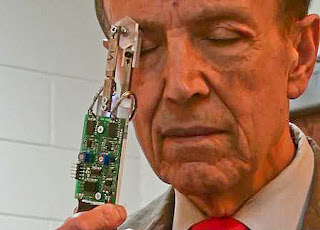TUCSON, Ariz. -- Cumbersome glaucoma tests requiring a visit to the ophthalmologist could soon be history thanks to a home test developed by an engineer at the University of Arizona.
A new hand-held instrument involving a system of micro-force sensors, specially designed microchips, and math-based programmed procedures has been designed by researchers at the UA College of Engineering. The easy-to-use probe gently rubs the eyelid and can be used at home, threatening to replace painful eye drops and the need for a sterilized sensor.
"You simply close your eye and rub the eyelid like you might casually rub your eye," said Eniko Enikov, professor of aerospace and mechanical engineering and head of the Advanced Micro and Nanosystems Laboratory at the University of Arizona's College of Engineering. "The instrument detects the stiffness and, therefore, infers the intraocular pressure," Enikov said.
Work on the probe began four years ago in collaboration with Dr. Gholan Peyman, a Phoenix ophthalmologist. The instrument went through several years of refinement and modifications to arrive at the current design, a prototype instrument that's noninvasive and simpler than current procedures.
The development work was funded through the National Science Foundation, and Enikov and Peyman now are seeking investors to help fund final development and commercialization of the product.
"The innovation with our device is that it's noninvasive, simpler to use and applies to a variety of situations that are either difficult to address or impossible to test using the current procedures," Enikov said. "That's why we're so excited about this probe. It has great potential to improve medical care, and significant commercial possibilities, as well." ###
More information about the new glaucoma test instrument can be found at the University of Arizona College of Engineering website here www.engr.arizona.edu/news/story.php?id=225
More on the Advanced Micro and Nanosystems Laboratory can be found here nano.arizona.edu/ and more information on glaucoma, current research and treatments can be found here www.glaucoma.org/
Contact: Steve Delgado sdelgado@engr.arizona.edu 520-621-2815
University of Arizona College of Engineering















1 comment:
Fortunately treatment for most eye problems such as glaucoma is simple and quite common. There are a few alternatives which range from glaucoma treatments, to natural remedies, and then health techniques.
Ophthalmology
Post a Comment